About a year and a half ago, we ripped out 3/4 of the flooring in our house and put in LifeProof luxury vinyl flooring…by ourselves (and lived to tell the tale! 😉 Just kidding…it’s very DIY friendly).
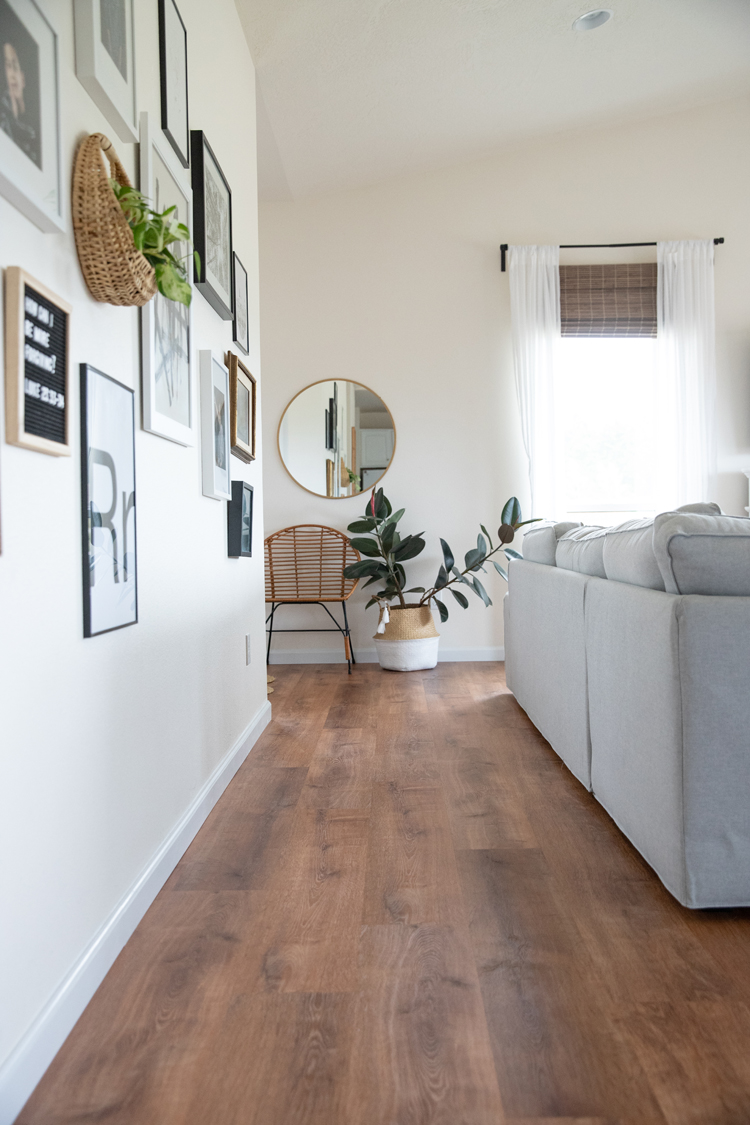
We live in a small-ish house, but it was still quite a project because we put it in our living room, both bathrooms, kitchen, laundry room, closets, hallways…basically everywhere but the bedrooms.
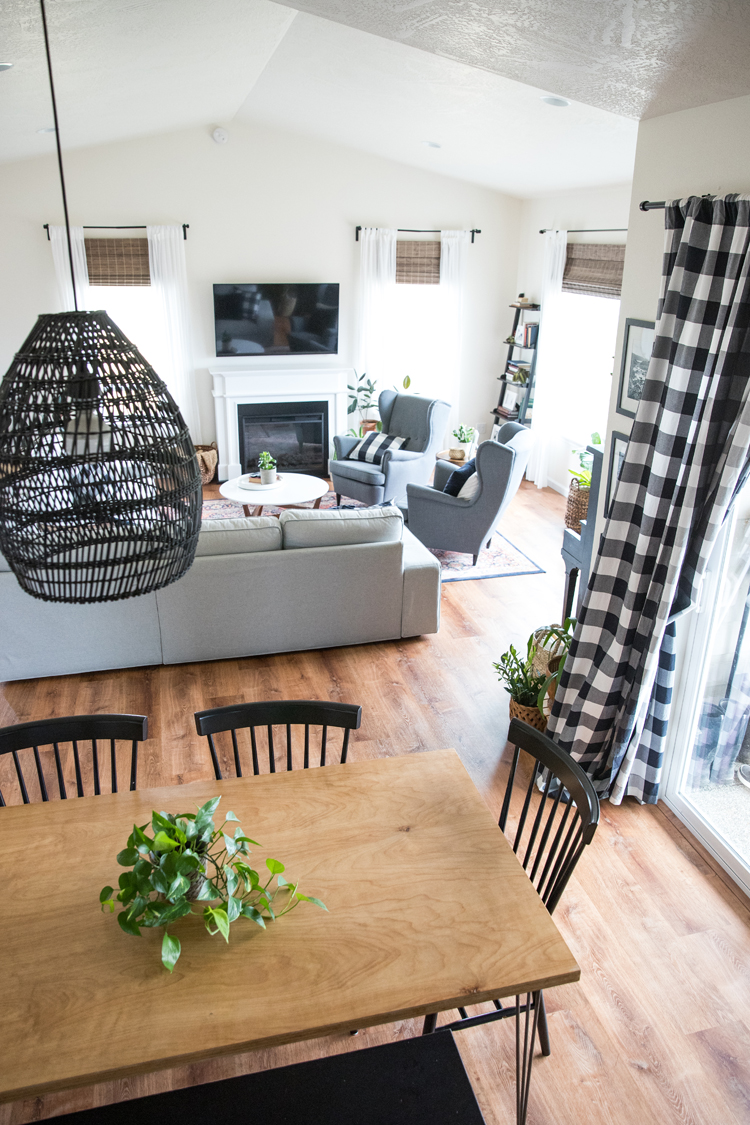
I have SO much to say about the whole process and I don’t want to leave anything out, so you can have all the information you need if you are thinking about installing LifeProof in your home too! So buckle up…this post is going to be a doozy!
I’m going to cover:
- Ordering the flooring, choosing a color, and how much it cost and how to get a discount.
- The prep work involved, tools we recommend, and how the floating floor system works.
- Installation, including layout, process, and how to install the planks.
- A review of how life proof it actually is a year later.
- Full cost breakdown.
- How long it took us and would we do it again.
If video is more your thing, here’s a video that gives an overview of the process and a tutorial on how to install it.
It doesn’t dive deep into the details but it gives you the nuts and bolts you need to get started.
ORDERING
In this section, I’m going to talk about why we went with luxury vinyl, how to choose a color, and how to get a discount on your flooring.
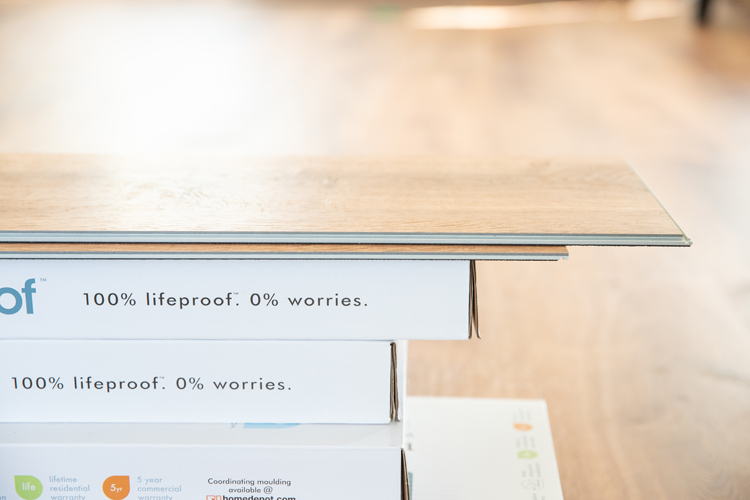
Why LifeProof?
When we first bought our home, it came with laminate plank flooring in the living areas, cheap sheet vinyl in the bathrooms, and a carpet island in the living room that I loathed. Our house is pretty small (1700 square feet) with an open concept living, dining, and kitchen area. I can see how the builder may have wanted to help separate the areas using the flooring, but it really just made our house look smaller.
We wanted continuous flooring that would match throughout the house, from bathrooms to living areas. So, we knew we needed to look into waterproof flooring. Tile is too cold for our northwest climate and we needed something that we felt we could do ourselves, since we didn’t have the budget to hire it out. Enter luxury plank vinyl. We hit up our local Home Depot for brands, and LifeProof seemed to have the best price and availability at that time.
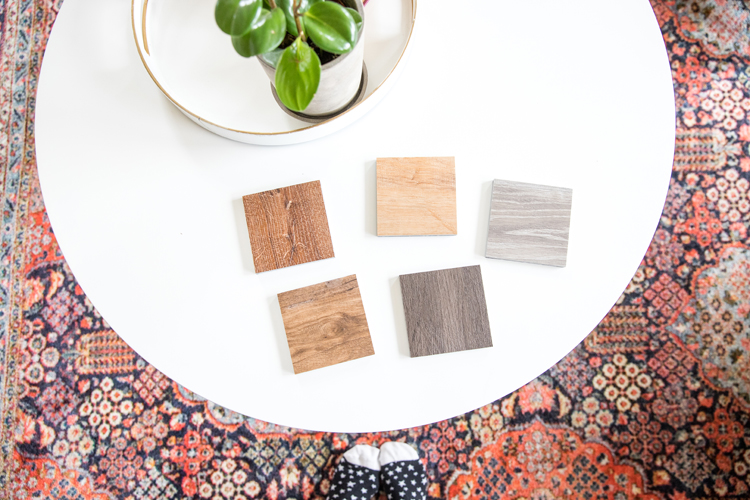
Choosing A Color
At the risk of sounding like a complainer…I promise I love our flooring and have no desire to change it…I am just not totally in love with the color. I know, I know. I’m the one who chose it, which is why I feel the need to caution you at this step. It can be tricky.
When you go in the store, they often have a small display of planks, and they may have a small 3-inch sample you can take home. The problem with such a small sampling of the flooring is that it’s hard to grasp how the variations in the different planks are going to play out on a larger scale. You have to go online and see the flooring installed in the product photos to get a better idea of how it’s really going to look. I would say that they are pretty accurate too. My sample squares weren’t quite as red as the photos online because some of the planks are lighter than others, so I thought it would be a little more toned down in person. After it was all installed, the tones ended up looking as red as the photos. So, trust the pictures! We went with Trail Oak. If I could do it all again, I would have gone with a lighter color like Fresh Oak or Dusk Cherry.
How To Get A Discount
We saved about 20% off our flooring by signing up as a “pro” at Home Depot. Anyone can get a discount by signing up for Pro Xtra. It’s free and pretty much like signing up for a membership card at a grocery store. You get discounts on certain items when you buy them in bulk…like flooring! I am uncertain what the minimum amount is that you need to order to qualify for the discount, and I imagine it varies from product to product and between seasons.
The flooring is normally about $64 per case. With our discount, we got each case at $51.33 before tax, which is just under 20% off.
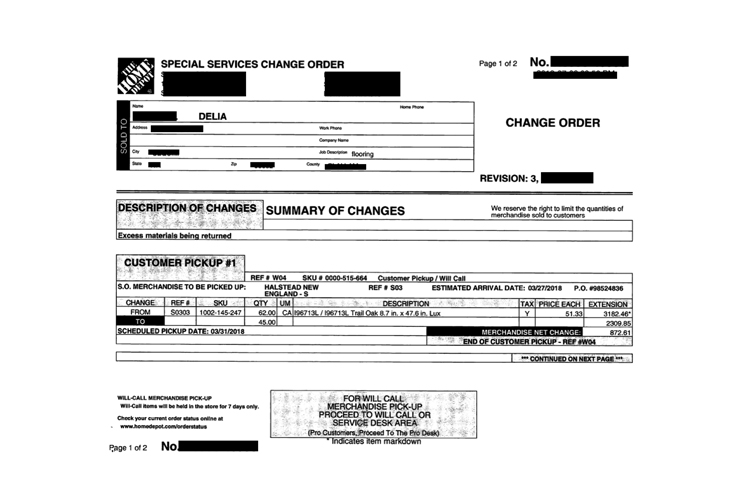
How much to order?
Give yourself as much time as possible and order at least a month in advance. We had shipping delays so I was glad we gave ourselves plenty of time to get it in.
We worked with the in-house flooring specialist to determine how much flooring we needed and we still ended up over shooting by kind of a lot. We ordered 62 cases and returned 17 of them when we were done. We just didn’t have as much waste as we expected. I’m glad we had too much rather than cutting it close though, because it would be really annoying if we had to wait another 3-4 weeks to order more to finish the project.
PREP WORK
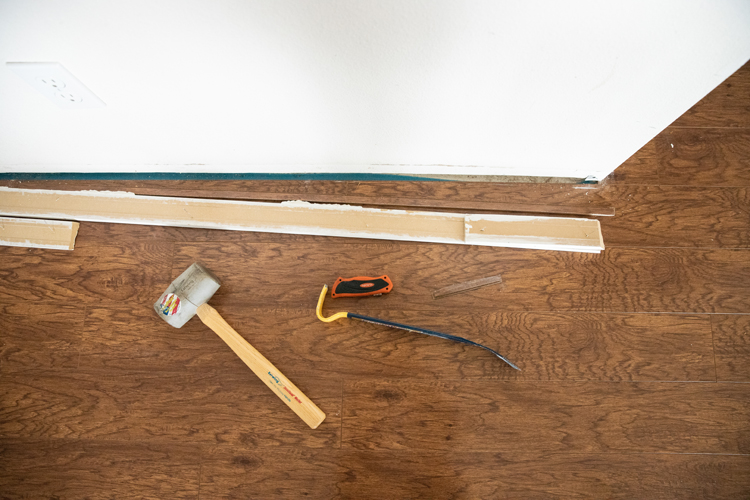
If there is one thing we underestimated the most, it would be how much prep work is involved. It took half a day at least to remove the old flooring, displace the furniture, remove carpet, and remove baseboards in just our living room. Our new flooring is a different height than our old flooring, so we decided it would be best to start from scratch. Also…removing and hauling all the carpeting to the dump is actually kind of a project of its own!
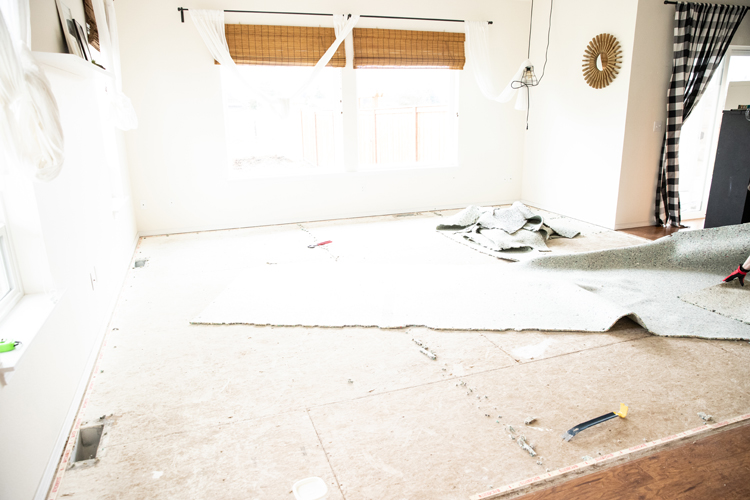
If you are removing carpeting, make sure to remove every single staple as well. Even the littlest staple left behind will ruin the integrity of the floating floor.
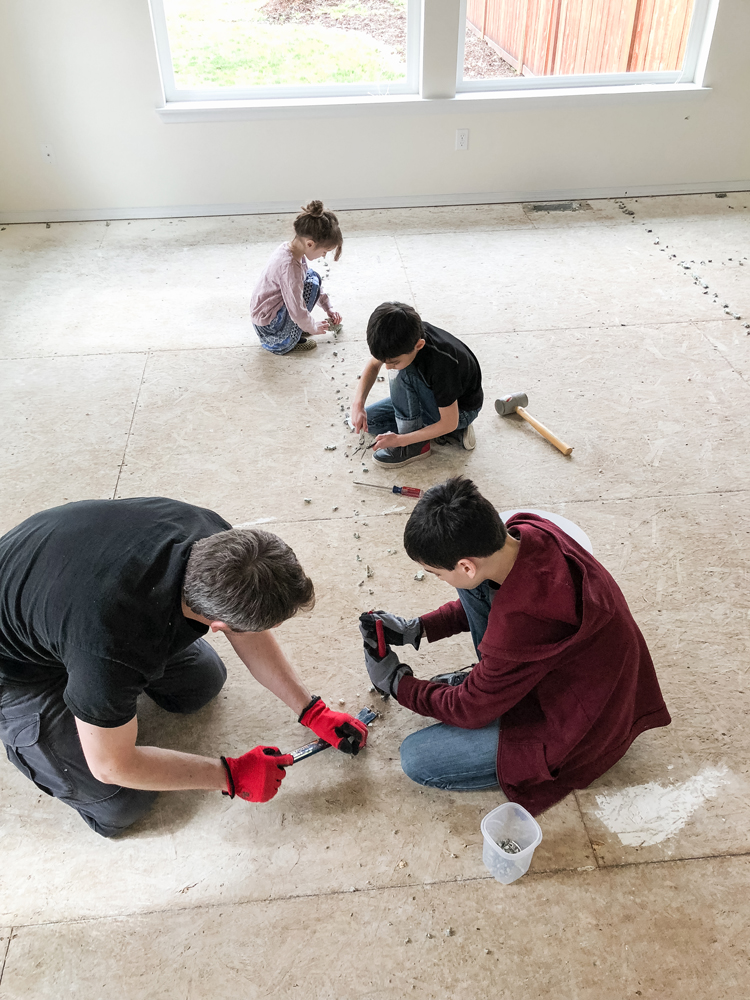
We worked through the house room by room since we were living through the renovation, so we couldn’t remove all the flooring ahead of time. But if we had to do it again, I would have at least removed all the baseboards while I waited for the flooring to be shipped.
One big plus, is that LifeProof comes with its own underlayment, so you don’t have to worry about that step.
TOOLS
Tapping Blocks and Mallets
They have the tapping block and mallet you need to buy, conveniently located next to the flooring displays for a reason. The right tools make everything so much easier to install. We tried getting by with our large bulky mallet to save money, but the smaller one makes tapping the sides so much easier. We kept the larger mallet around just for tapping in short ends.
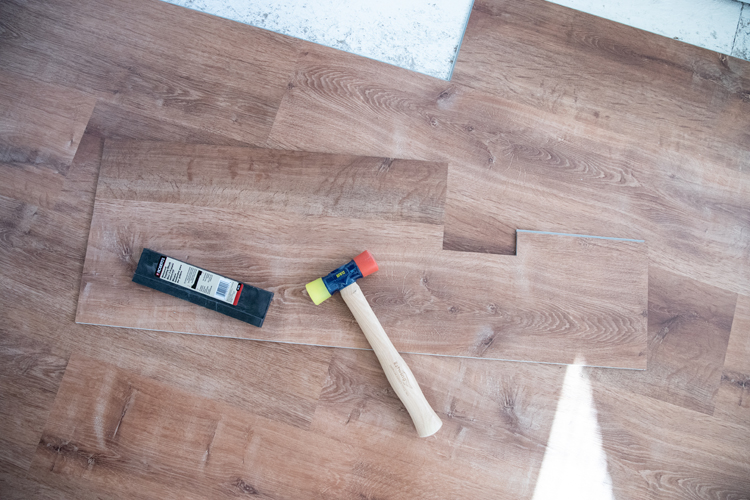
If you are putting in as much flooring as we did, I also recommend getting more than one tapping block. They have lipped edges that help protect the sides while you tap in the plank. Eventually those edges start to wear down and cause damage to the planks instead of protecting them, so it’s best to get a fresh one after a while.
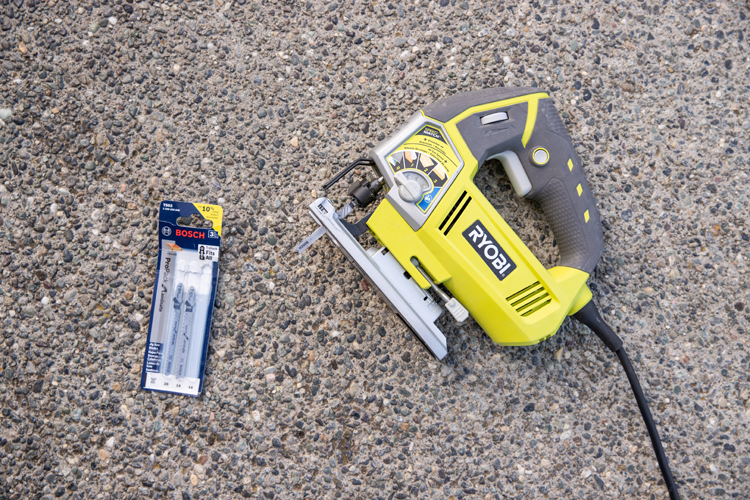
Cutting Tools
One of the selling points for LifeProof is that it’s so DIY friendly that you don’t need special tools to install it…just a utility knife. While this is technically true, you can score the vinyl side with a utility knife and then snap the rest off to cut the plank, I don’t recommend it. It’s hard on your hands which matters a lot when you’re installing a lot of flooring. It is also harder to be accurate and it can only handle straight cuts.
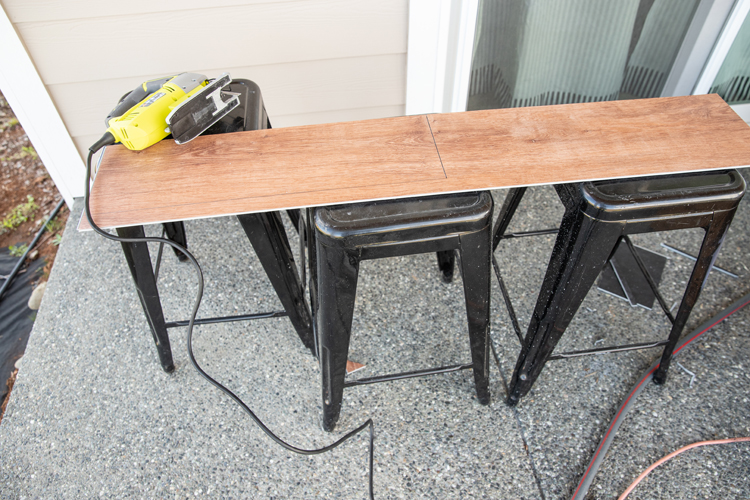

We ended up relying on our jig saw quite a bit. Because we wanted to have as few transitions as possible, that meant we had to do a lot of puzzle-piece cuts with funky curves and angles to get around door jams and corners. We didn’t have a professional set up or anything…just a bunch of metal stools propped up on our back porch to use as saw horses. It looks janky but it was actually really functional. Aside from the puzzle piece cuts, it was just so much easier to do our straight cuts with it as well. Sometimes we used our miter saw for straight cuts which was even easier. With each tool, we always made sure to use a blade that is rated for use with laminate. Other blades rough up or melt the planks.
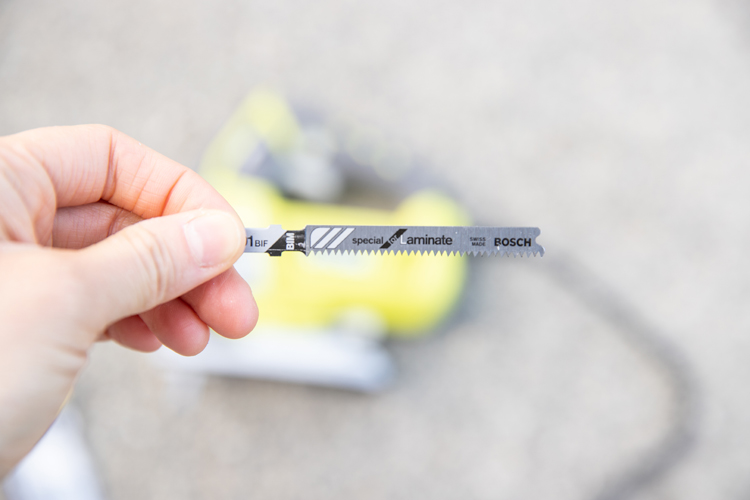
Other Helpful Tools
- Newspaper
- Quilting Ruler
- Vacuum
- Crow Bar
- Staple Remover Pliers
- Spacers
- Knee pads or gardening pad
Newspaper – If you have a lot of corners and angles to contend with like we did, I recommend using grocery ads, newspapers, or any large pieces of paper, to help create paper templates for funky cuts. This helped us cut down on flooring waste a TON.
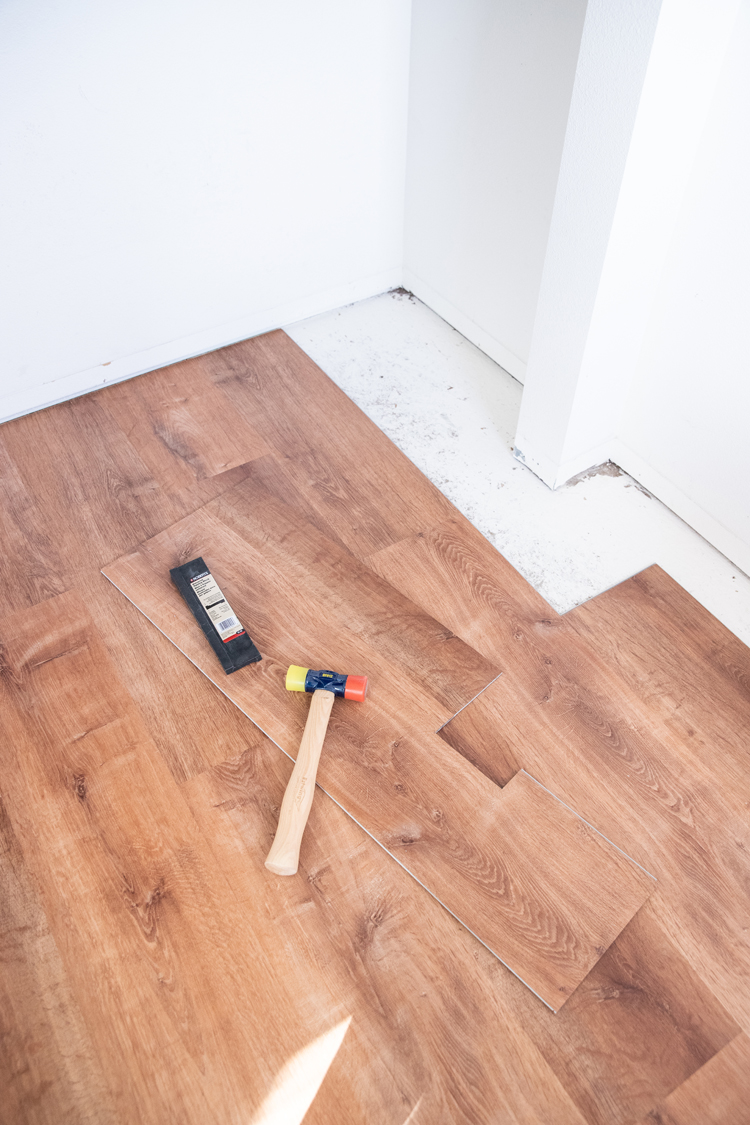
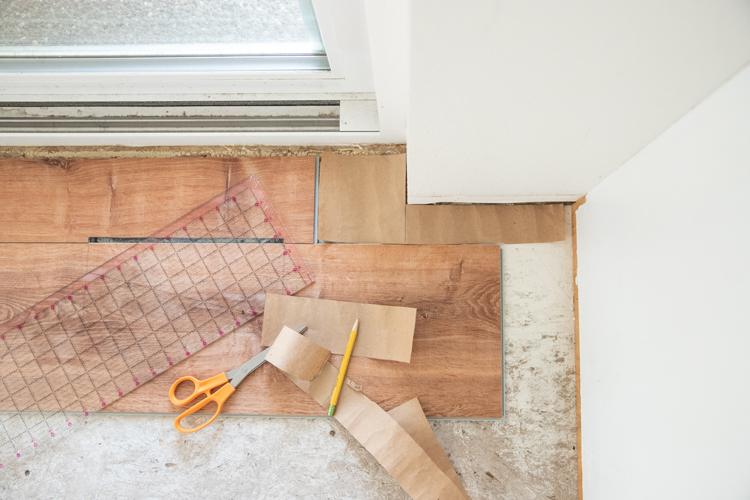
Quilting Ruler – Another helpful tool is a quilting ruler. I think it’s the MVP of tools in any medium actually. 😉 It gives you a see through grid of measurements that are much more accurate than using a straight edge ruler.
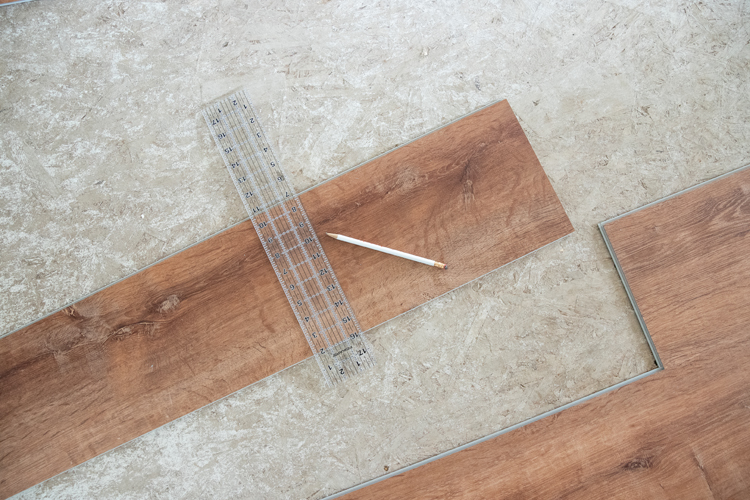
Vacuum – No matter how well we swept and vacuumed an area before we started laying planks, dust and rocks would creep their way under the the planks and into the connector grooves. Having a hand vac on hand helped us keep the sides and ends clean so they could provide a secure connection.
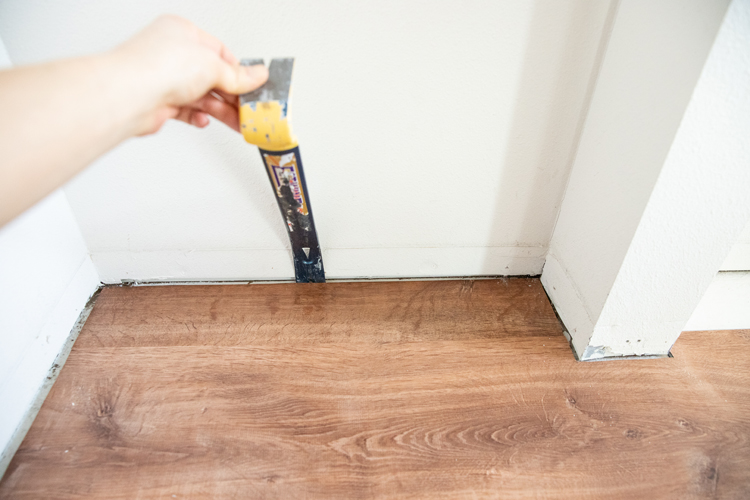
Crow Bar – this not only helps with removing baseboards but is great at snapping in the last row of planks when the tapping block won’t fit anymore.
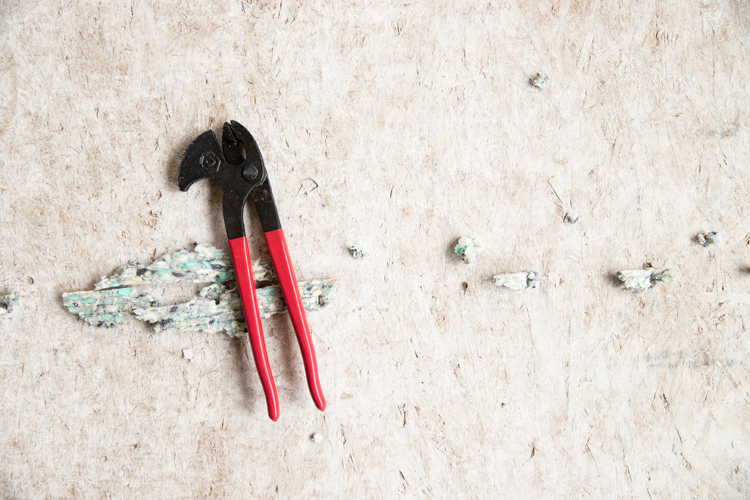
Staple Remover Pliers – If you are removing carpeting or baseboards, these pliers are awesome. They make removing all the staples and pin nails so much easier. If you’re removing hundreds of staples like we did, it’s worth it to spend about $18 on this puppy.
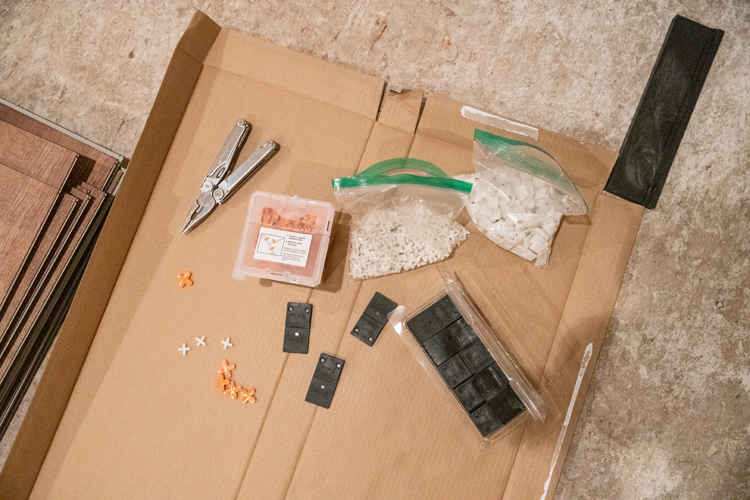
Spacers – To give your flooring room to expand and contract, you don’t want to lay your planks flush with the wall. We picked up a variety of spacers to help us keep the proper distance from the wall. Smaller spacers were great for tight spaces.
Knee pads – Because you will be kneeling on a hard surface for a long time, it helps to get knee pads or a towel you can kneel on. I also used a gardening pad.
Before you get started:
LAYOUT
I’ve seen vinyl plank flooring installed from both sides of a plank. I’ve also seen it hooked together and then unhooked to get the configuration correct. I don’t know if it’s just us, but I have NO idea how this could be possible with LifeProof flooring. Once the long sides are hooked and tapped together, it is impossible to disconnect them without damaging at least one of the boards. The short ends are a different story and you can usually salvage the planks by sliding them apart. To show you what I mean, we have to talk about the anatomy of the planks or boards.
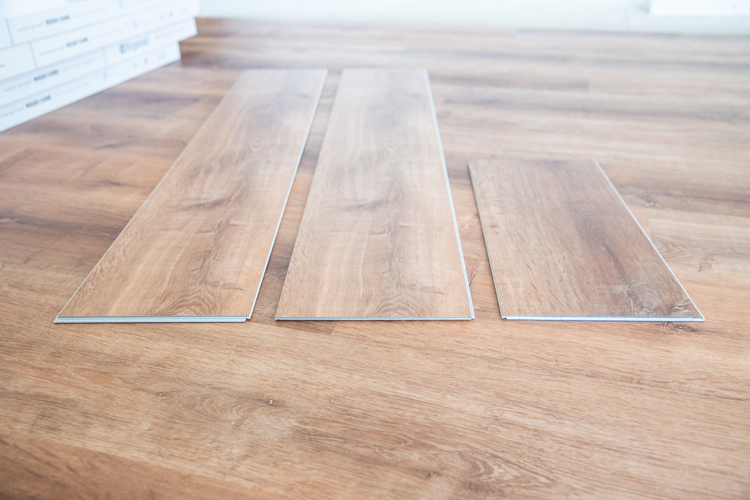
Plank Anatomy
Luxury vinyl is a floating floor which means that the planks are hooked together rather than adhered or nailed into the subfloor. Each plank has a long side and a short end that hooks OVER, and a long side and a short end that hooks UNDER. When these get hooked together, it is what creates the floating floor and seals out the water. This picture above shows the under hook, over hook, and what it looks like when it’s cut straight, from left to right.
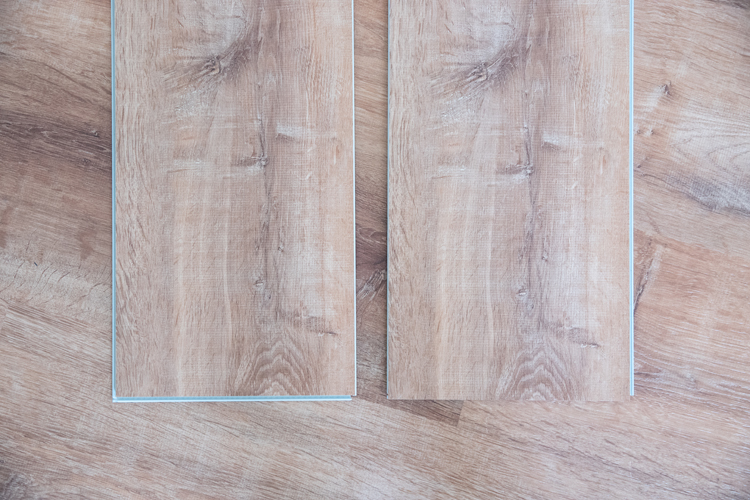
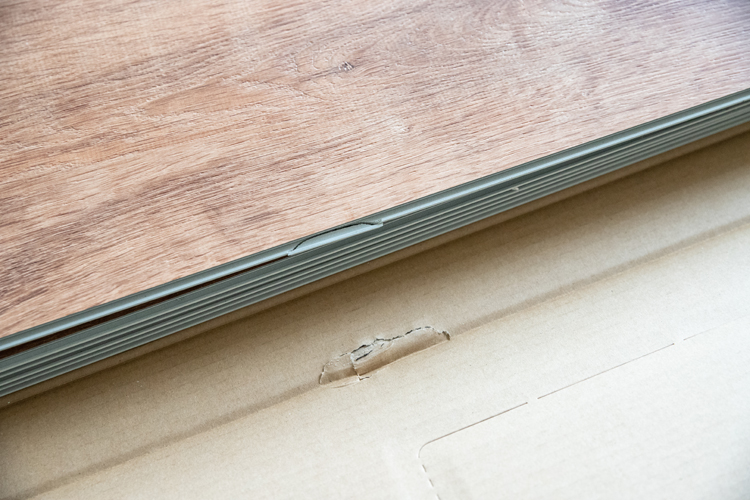
While these foam hook sides are very durable once connected and installed, before installation they can become damaged fairly easily. Hence, once you pull them apart, at least one of the planks will break and will not give a water tight connection after that.
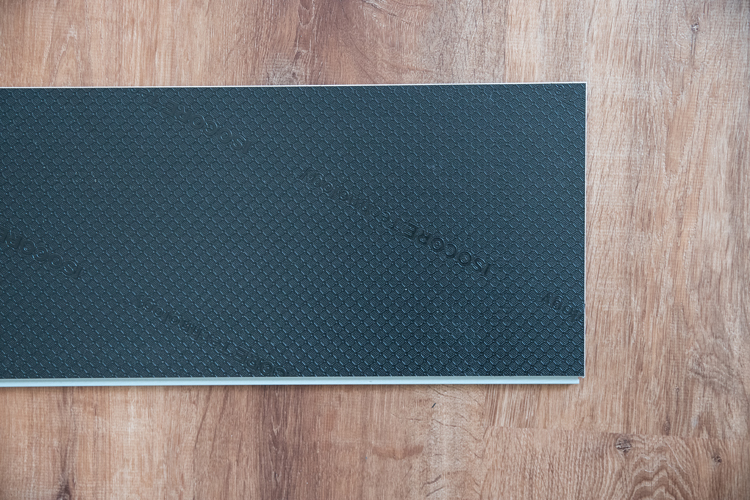
The top side of the plank is vinyl and the underside is the foam core with built-in waterproof underlayment.
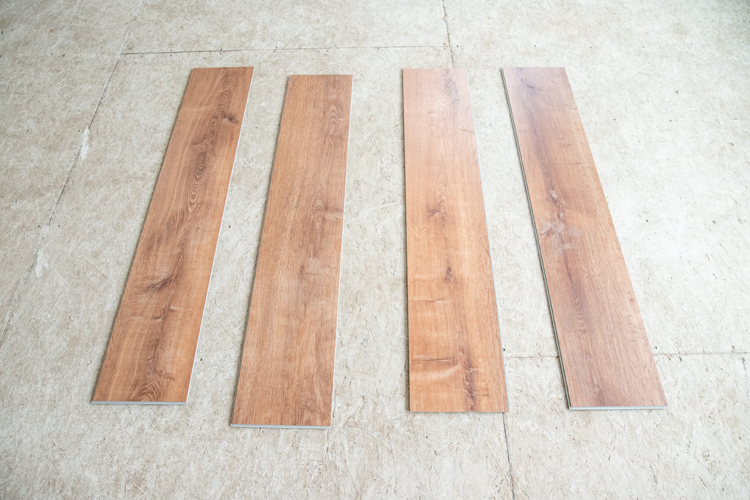
There are four repeating styles of planks. Whenever we opened a box, we sorted the planks into those four types, to help us maintain variety as we laid them.
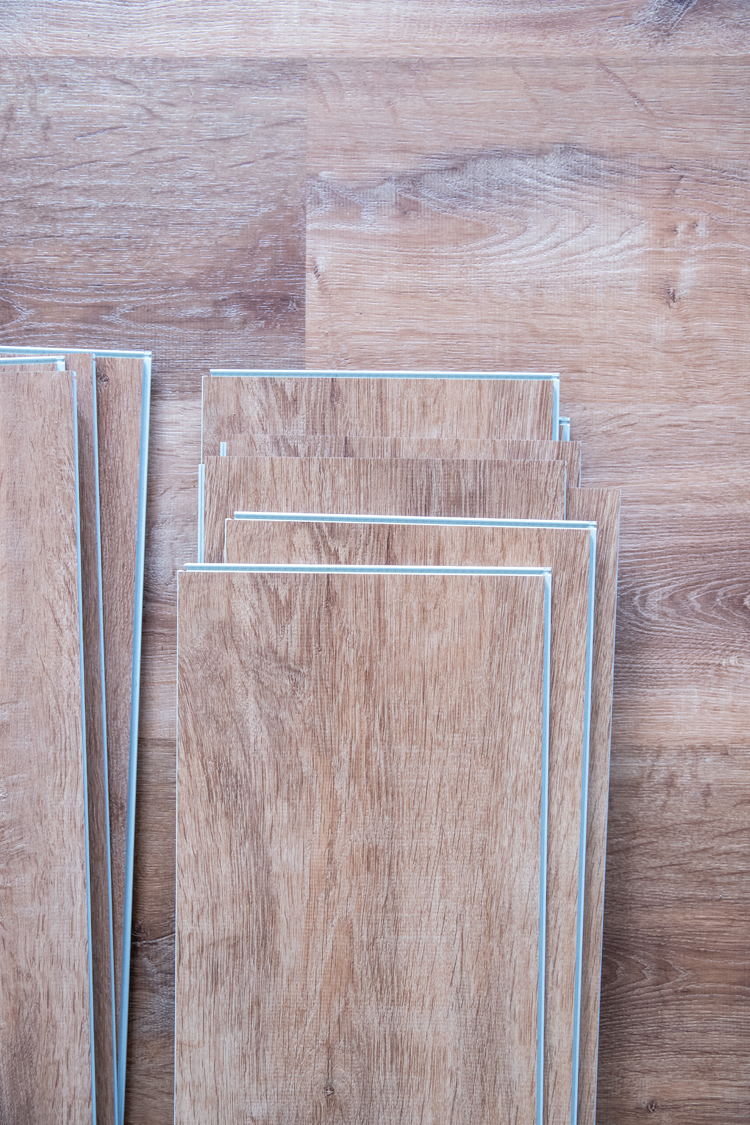
Where to start and which direction to go?
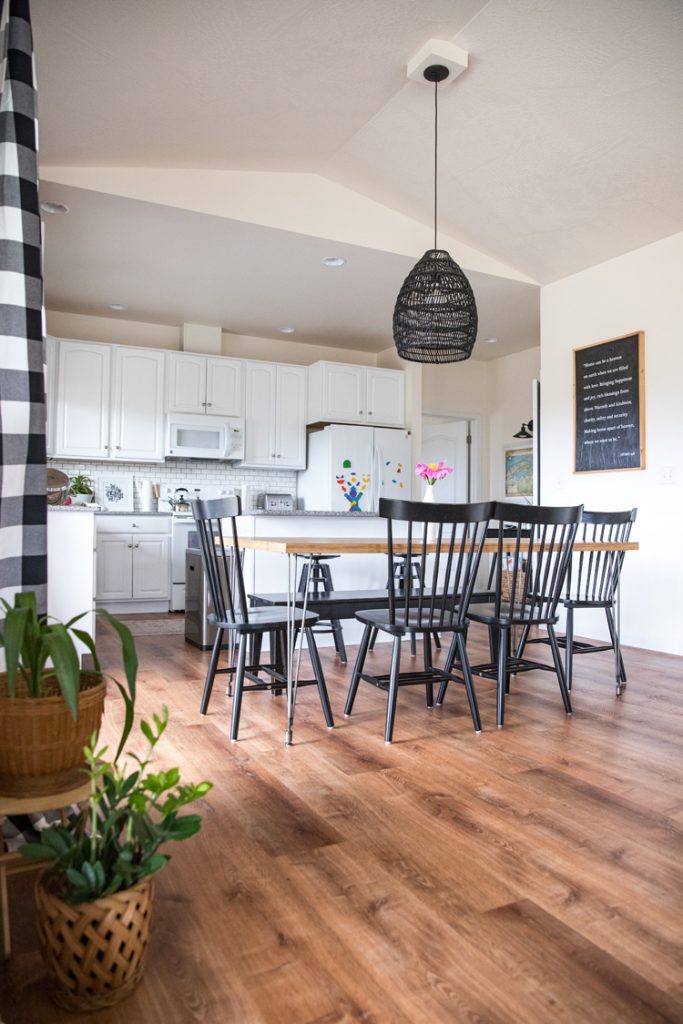
You usually want the flooring to flow vertically with the longest part of the room. Once you have determined the direction you want your flooring to go, face the room in that direction and determine your bottom, left hand corner. That is where you want to begin. Place a plank with the UNDER hooks exposed (away from the walls) at the short end and long side, so that it is easier to hook in subsequent planks. You then want to work your way from bottom to top, left to right.
Staggering
You never want your short end seams closer than 8 inches to ensure the stability of the floating floor. We didn’t want the planks to look like brick work, so we varied the starting plank lengths to help the layout flow more naturally. We also tried to avoid cutting planks shorter than 8 inches.
When we got to tricky corners and especially in closets, this was impossible. Thankfully, we haven’t had any issues with the smaller pieces buckling or shifting…even though some of the pieces are an inch long! I think it’s partly because those areas see much less foot traffic.
INSTALLATION
Prepare sub flooring
Remove old flooring. If the sub floor is not flat and level throughout, consider patching and leveling it before you begin. You can lay LifeProof over existing flooring if it is uniformly flat and level. Tile with deep grout grooves is not recommended. Sheet vinyl flooring works great. We had sheet vinyl in our bathrooms, so we just laid the LifeProof flooring right over top in those areas.
Cleaning
Make sure the floor is clean and clear, that any carpet staples are removed, and that rocks are picked up. Any little rock or staple trapped under a floating floor will cause the floor to buckle later. We also swept and vacuumed beforehand and as we worked to keep dust and rocks from getting in the way of the planks connecting properly.
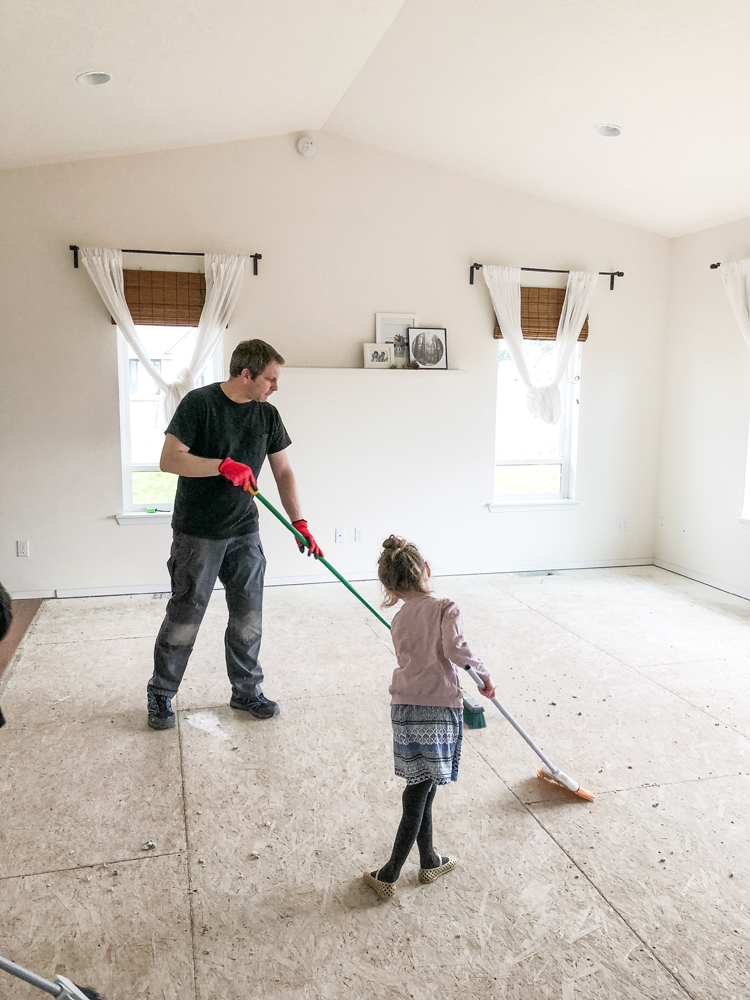
Lay Flooring
To install, first connect a row of planks at the short ends. Then add a row to the right of the first row. Angle a plank into the previous row to get the long sides to hook together. The hooks are like a track that you can slide the plank up and down. Slide it down to the meet the short end of the board before it.
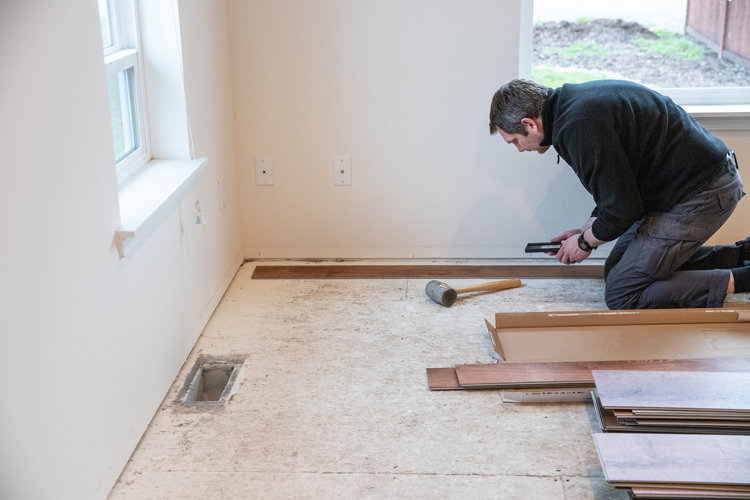
Push the tapping block up to the side of the plank and use the mallet to snap it in place. Then use a mallet to snap the short ends together. My video shows the installation process in action if you’re more of a visual person.
Continue working from bottom to top and left to right.
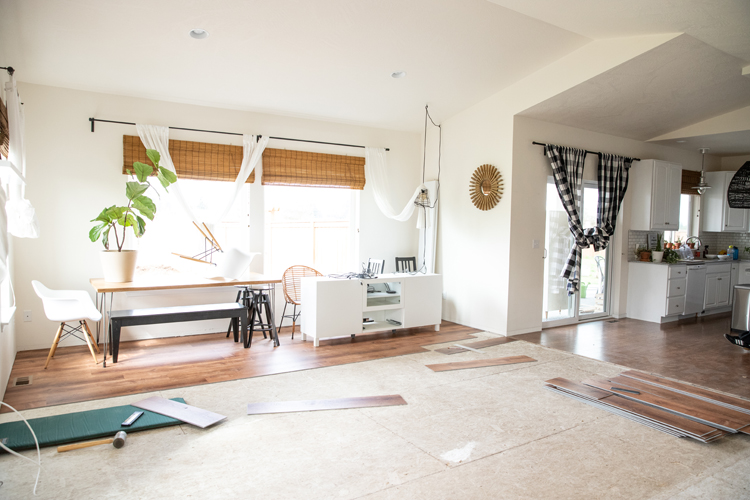
When you get to the right side of the room and the tapping block won’t fit anymore, a crow bar helps snap the planks in place.

For this tricky part of the closet, I snapped the last little skinny piece into the last full-width plank first, so that I could snap it in place as if it was one big plank.

Transitions
We used these vinyl transition strips at every exterior door, or where the flooring met with a different kind of flooring. We ended up having to do a stepped transition piece into the kids’ bathroom as well because the sub flooring had an extra layer of plywood glued to it and we didn’t want to have to try to remove it. It made the floor just slightly taller, so this reducer transition piece smooths out that height difference.
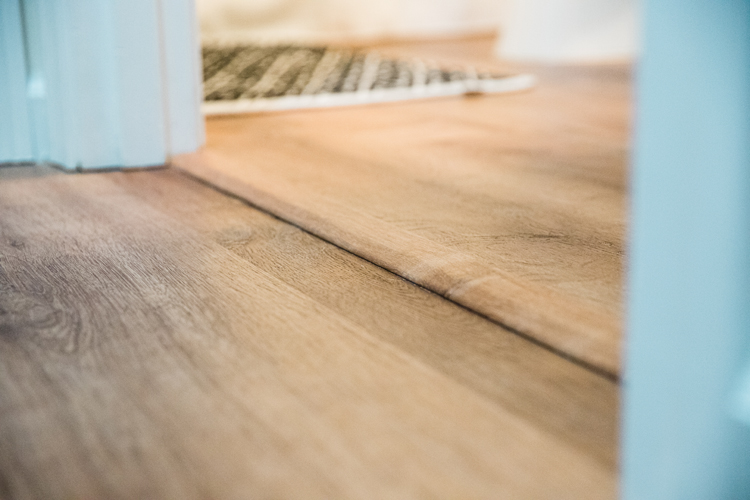
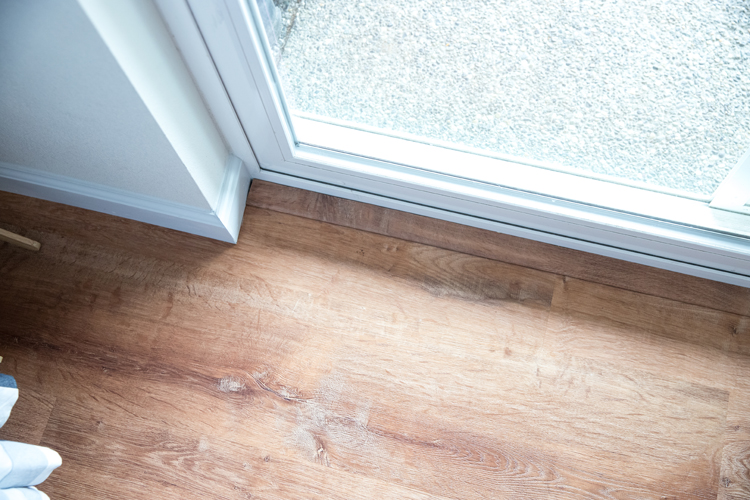
To install them, you simply cut the metal brackets that come with it to the size you need and screw them into the sub floor. Then cut the vinyl piece to size and snap it into the metal bracket. Easy peasy.
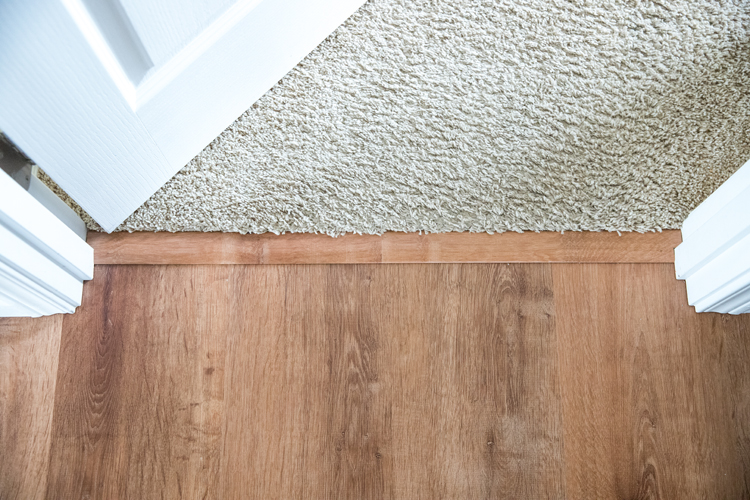
Then replace the baseboards…which sounds easy, but we ended up hiring this out eventually. We were just so burned out and couldn’t find the time to do something that someone else could complete better and faster than us. 😉
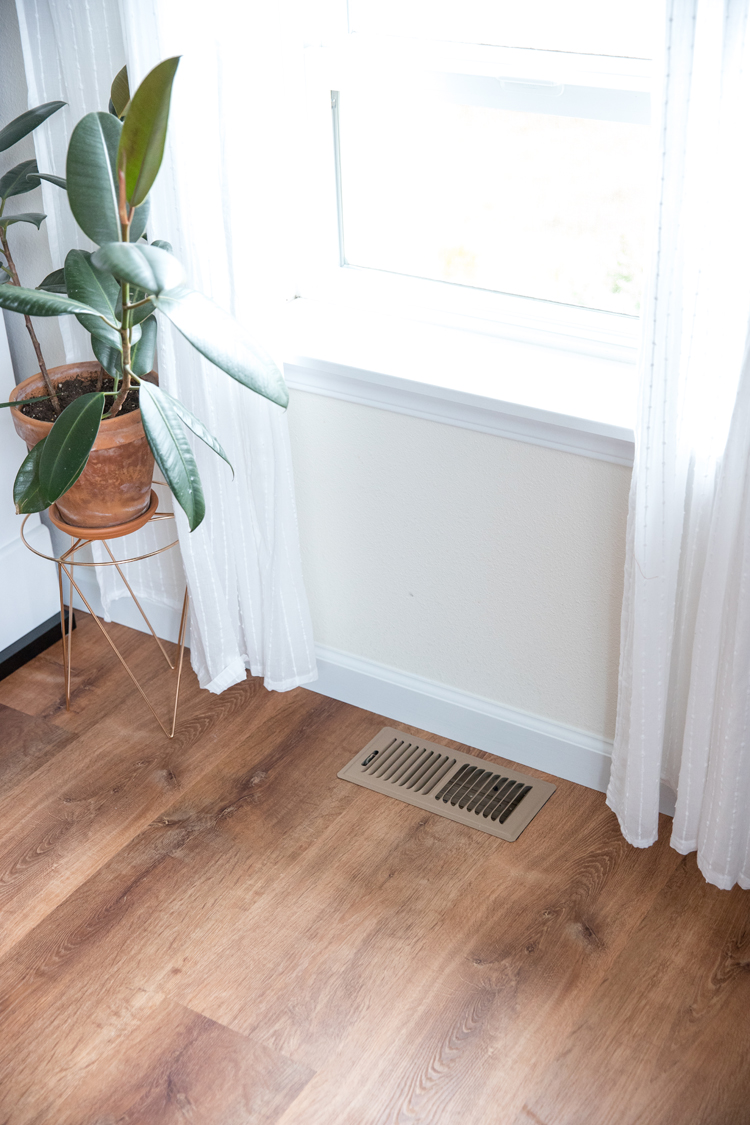
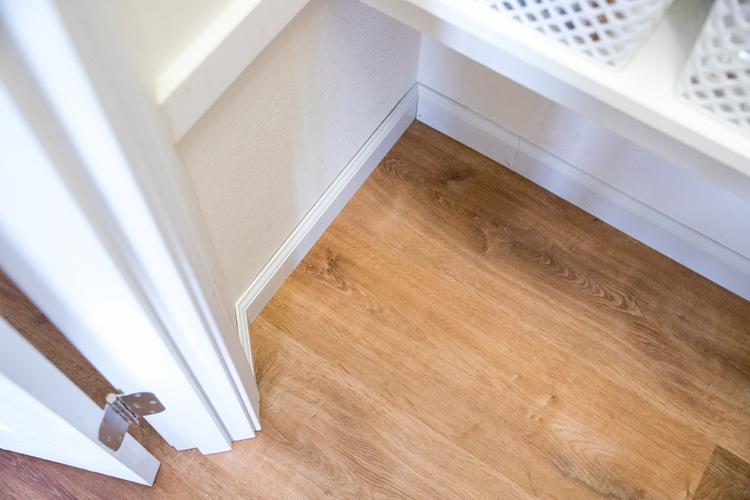
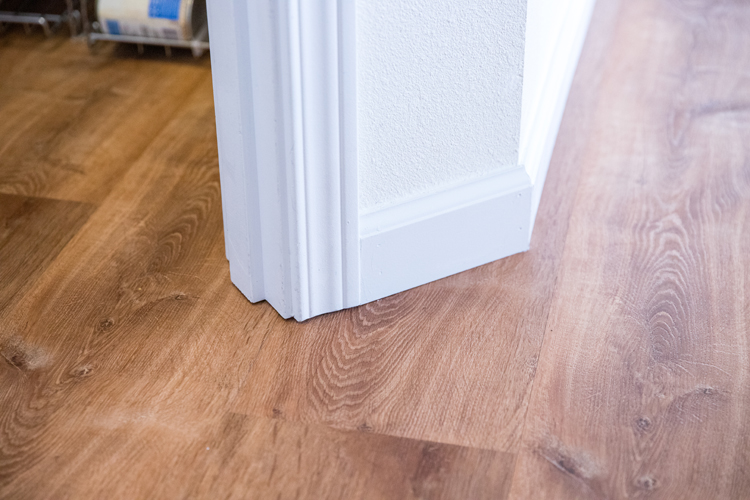
How it’s holding up a year later.
The one good thing about me putting off sharing this process for so long is that I can give a more comprehensive review of how “life proof” it really is.
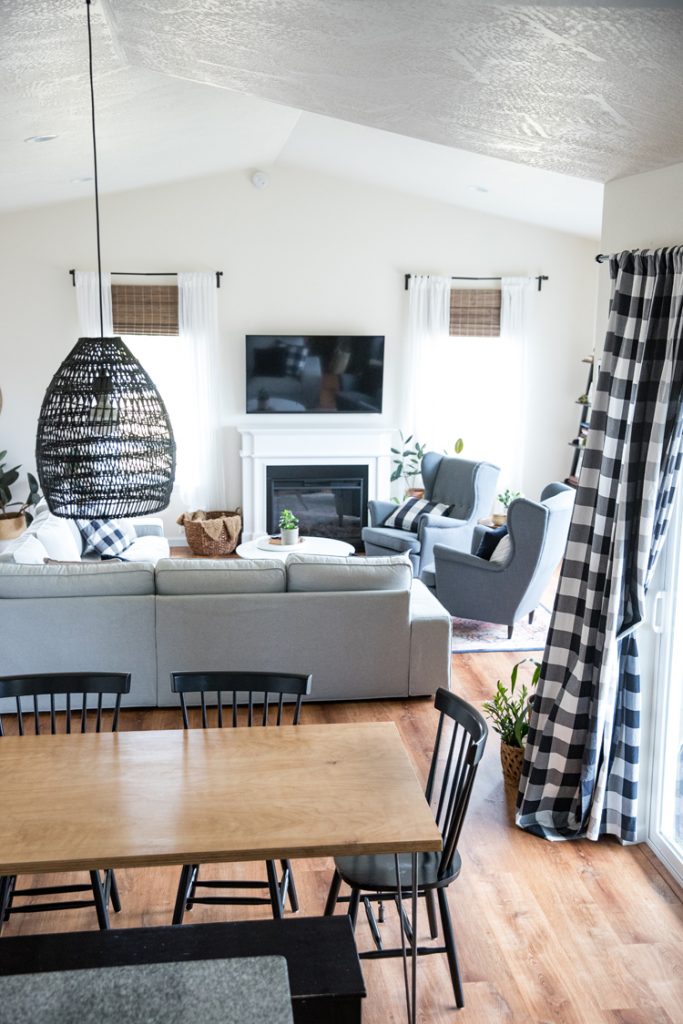
While we do like the flooring and we like how we were able to install it with no prior training or experience, it is not totally “life proof” in my opinion. It still gets scratches and cuts that you can’t buff out like you can with wood flooring. Rocks stuck in shoes or on the legs of furniture can leave behind marks. You can’t replace boards in the middle of the flooring either because it will just break its water proof seal. Thankfully the grain of the “wood” pattern is busy enough that you can’t really notice scratches all that much.
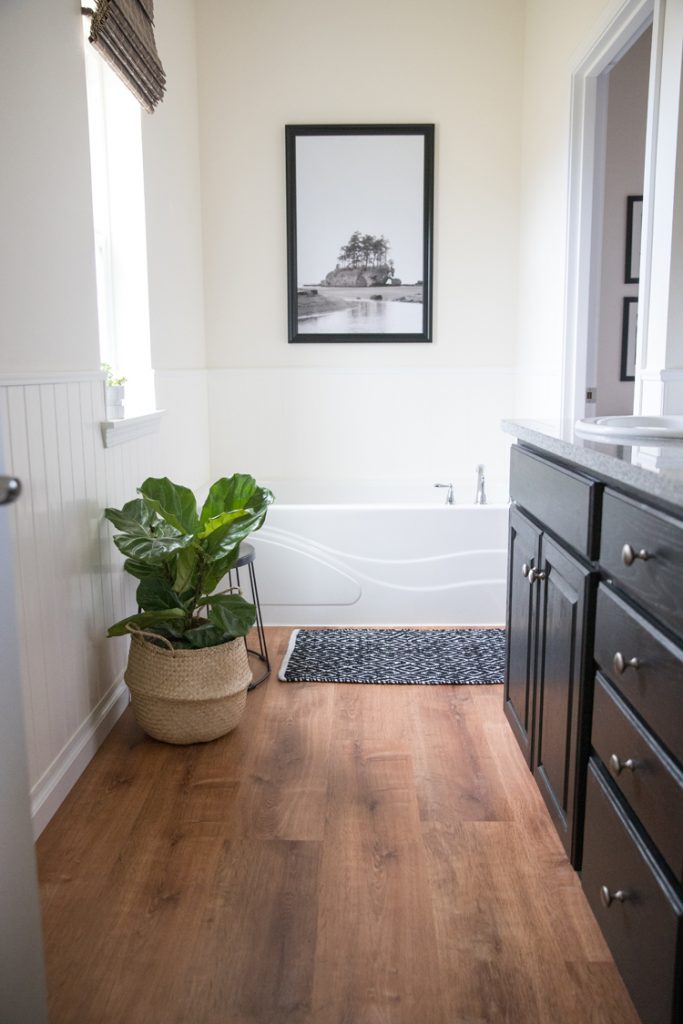
That said, its claims to be waterproof have held up beautifully, which was the biggest selling point for us since we wanted it in wet areas like our bathrooms. There hasn’t been any shifting or buckling and it still looks as good as the day we finished it, minus a few scratches that are hardly noticeable. So…not life proof, but definitely waterproof and for that reason, we recommend it.
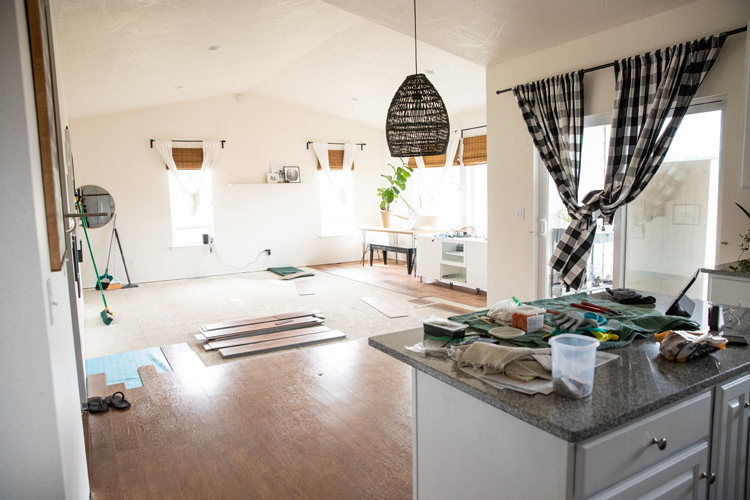
Cost Breakdown
*These amounts are pre-tax.
- LifeProof Flooring (with the discount and after the overage that we returned) – $ 2309.85
- Transition Strips (4 at $22.98 each) – $91.92
- Laminate Blades (5 at $5.97 each, they dulled fairly quickly) – $29.85
- Jig Saw (we already had it, but I’m including to show it’s not that expensive) – $49.97
- Nail Pulling Pliers (only needed if removing carpet and baseboards)- $17.97
- Spacers (We used three varieties) – about $18
- Tapping Block ($7.97 each, we used two because the first one wore out) – $15.94
- Specialty Mallet – $14.97
- Crow Bar (great for removing baseboards and installing the last row of planks) – $6.67
Total before tax: $2.555.14
This doesn’t include the cost of replacing our baseboards because we decided to replace them with nicer material, but we could have kept them the same. Overall, that total is amazing considering what an impact it made. If we hired it out, it probably would have almost doubled this total and it may not have been completed as precisely as we wanted it.
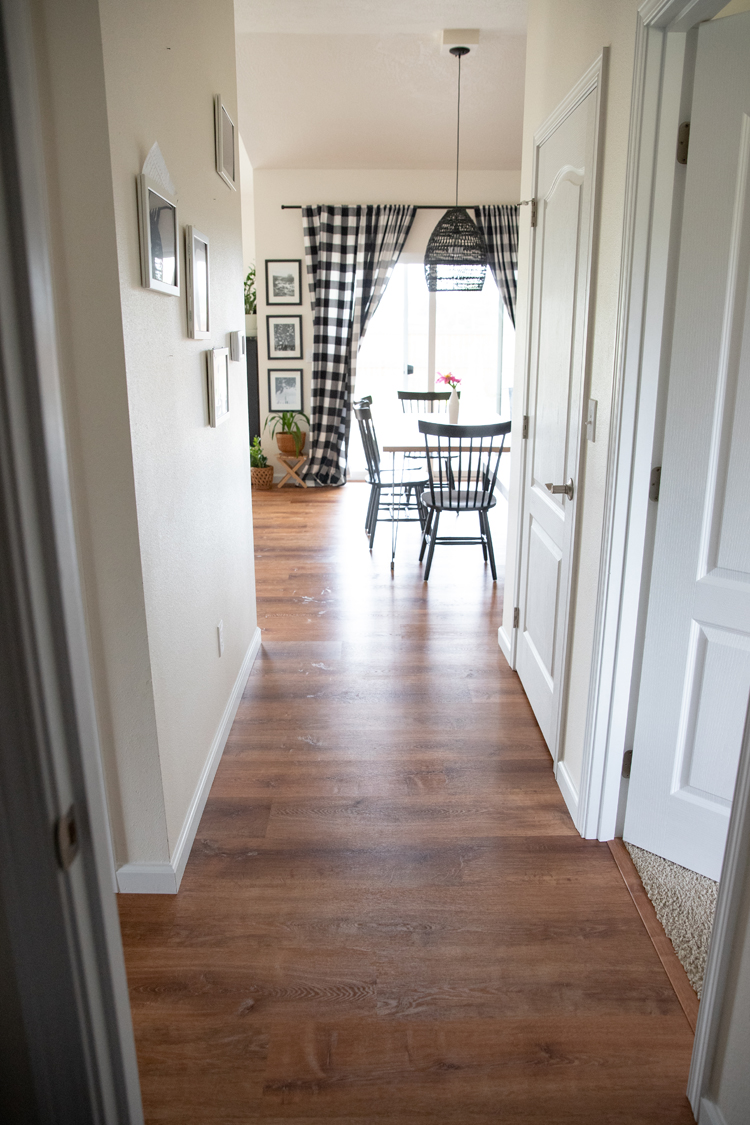
How Long Did it Take?
Overall, the process took us about 6 months, not including adding new baseboards. It’s not that actually installing it took that long, but finding the time in our busy schedules and making it a priority was not the easiest. For certain rooms like the bathrooms and laundry room, it wasn’t something we could pick and up and put down very easily. We tackled each bathroom one at a time because we had to remove the toilets. We also wanted the baseboards and caulking to go in right after installation to keep things water tight. So a lot of the timeline got sucked into juggling our schedules and fighting burn out.
Would we do it again?
Yes and no. If we’re doing it in an empty house or if we’re just tackling one room, I’d definitely go for it again. Otherwise, we’d save up money and hire it out. Living in a renovation for this long can be kind of depressing!
I also like the benefits of LifeProof for certain areas of the home. It’s not nice as wood, but it’s less maintenance. We’ve actually had several visitors mistake it for real wood so I know I’m probably on the picky side. One thing I am sure of, is I would definitely never go with laminate flooring that isn’t waterproof. It’s either luxury vinyl, or go for the real stuff.
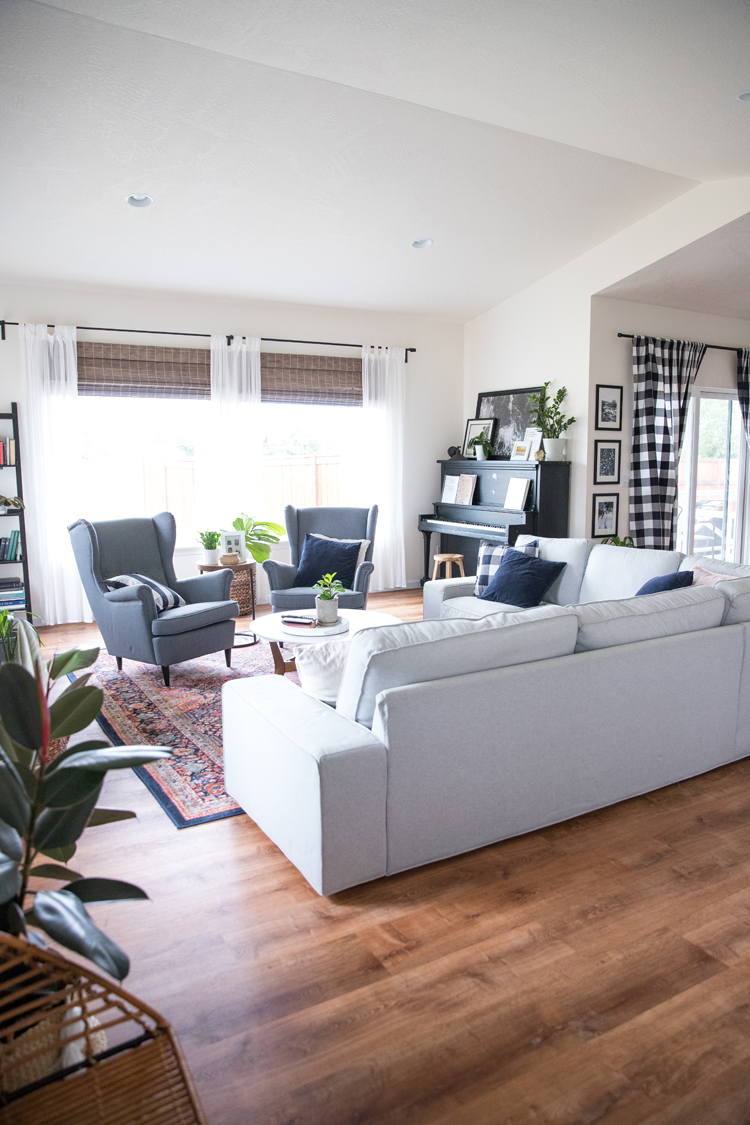
All in all…I am so happy it’s done. It has added value to our home and it makes me so happy to walk in the bathrooms and laundry room and not see the yellowing vinyl flooring that was in there before!

Phew! What a post! If after all that you still have questions, I would love to try to help answer what I can. Drop a comment or email me at [email protected].


I love this! We did our master bath with remnants we found on Facebook marketplace; only 100 sq ft. Regarding color choice, I was told at the store to take a box home, open it, and lay out a bunch of planks to really see it throughout the day and night as lighting changes. Then return it if you don’t like it.
Question 1: Did you change directions from hall to bathroom, or keep it going all one way?
Question 2: Do you know if they have an option for stairs?
That’s a great tip on choosing color! We unfortunately had to wait weeks to get even one box. I should have been more patient. To answer your questions, we did not change direction in hallways and the laundry room because we didn’t want to have any transitions. We ended up needing a transition in the second bathroom due to different subfloor heights, but we kept the flooring going in the same direction anyway. As for stairs, I don’t know about that. Sorry, I don’t have a better answer.
We live in a double-wide manufactured home and are putting the LIfeproof flooring in all of the main rooms and hallway. However, we have vinyl flooring that is still existing in the dining room, kitchen and hall. We are planning to put some liner in the areas where we took out the carpeting. Is this necessary, or will it matter if there is still a vinyl flooring on part of the floor?
Good question! You don’t need to put in a liner or anything under the planks. We put lifeproof right over our subfloor. As far as making it even with the vinyl flooring though…I suppose you could put in underlayment to bring it up to the height of the vinyl, though I’ve never tried it and I don’t know how well it would work. I only know that the flooring needs to be flush and even throughout or your planks could buckle down the road. Sorry, I don’t have a better answer.
I love the look! Can I ask what color the paint is on your walls? We are installing Lifeproof vinyl in our house and also want to paint the walls a light beige, but there are just so many shades to choose. These pictures are my inspiration for how I want our living room to look!
Thank you! I feel so honored that you would take inspiration from our living room. I wish I could tell you the paint color, but the house was this color when we moved in and it didn’t come with touch up paint. I’ve had to color match it for touch ups. It looks like a warmer white. I hope that helps?
Thank you for your tips. One quick question, we are doing our entire main floor in LifeProof and living there at the same time. Is it ok to lay flooring in each room and once that room is complete move the furniture back in and continue to the next room?
Yes, absolutely. That is what we did. We shuffled furniture onto finished sections of flooring since we lived through our flooring installation too. For high traffic areas, we laid down layers of towels to protect the connector sides of the planks until we were ready to continue the flooring. You don’t want the gray tracks on the side to be damaged at all. We also made sure to give the area a good vacuuming before continuing so that any dust or lint from the towels that may have built up around the exposed planks wouldn’t impede a good connection. I hope that helps. Best of luck with the project!
Great job throwing this process together for us ! One question though : did you have to remove /cut door moldings and upright moldings between your rooms to fit the flooring under them , or somehow trim them off 1/2 inch or so installed ? Thanks and looks GREAT .
Thank you! That is a great question. We only had to under cut door moldings in areas where we didn’t remove the existing flooring. So in our master bathroom, we laid LifeProof right over top of the vinyl sheet flooring that was already there. We used a Dremel tool with a saw attachment to shave off the moldings. For the rest of the house though, we removed the old flooring so it wasn’t an issue. I hope that helps!
oops , actually not home depot directly buy deliacreats.com
This looks great and thank you for sharing. I am using Trail Oak for a rental and am also scared about the red tint of it. Unfortunately, we don’t have time to wait on any other colors. My question is did you edit these pictures at all (the color)? If not, I see that there is a red tint but I still like the medium color over the Fresh Oak (that is showing more of a grey undertone).
Great question. I did not edit the photos to look less red or increase/decrease the warmth per se, but depending on the lighting and time of day the red seems to wash out of the photo sometimes. At night it is more noticeable. During the day, less so. I hope that helps.
Oh and best wishes with the install! I’m excited for you!
Thank you so much for this post. It’s so hard to pick a color. May I ask you if you removed the washer and dryer to install the planks underneath?
Good question. Picking a color is probably the hardest part, but it’s worth making sure you love it. We did remove our washer and dryer. We moved them to another part of the house, using thick cardboard to carefully slide it over planks that were already installed, so we wouldn’t damage the somewhat fragile foam hooks. I hope that helps. Let me know if you have any further questions.
This is an excellent post for DIYers like me! You answered most of my questions to decide if I should tackle this project myself or pay more for pro installation. The only question left is how you handled the transition up to the tub? It looks flawless in the photo, but I can’t tell how it’s finished. Thank you!
So glad you found this helpful! Great question. I had the planks go all the way up to the edge of the bath tub, leaving little to no gap (there is plenty of gap for expansion and contraction on the other sides by the wall and door). Then I sealed it with waterproof caulking like I did around the base of the toilet. I hope that helps. Please let me know if you have any other questions.
Hi – I was wondering what color the floor is? Been having such a difficult time picking a color. Your looks beautiful!
Thanks! This is Trail Oak. They have come out with more variations of this “oak” that are beautiful too. It is worth it to order a sample box, if you’re not in a hurry.
Great post! Very helpful! I just wanted to ask what the square footage of your home is. How much flooring you did for your home.
Sure! Our home is about 1700 square feet and we laid this flooring down in every space except bedrooms. I listed the amounts in the post if you are interested in that.
Hello. My husband and I are in the process of deciding on color. Our home is 1800/sf and plan to do all of it, and possibly have friends help install because home depot is crazy expensive to install. I signed up for the PRO membership as you stated in the article to get 20% off. How do you actually get the 20% off? I went to the website online and couldn’t figure out a way to do so. Do you have to order in store to obtain the discount? That’s an amazing deal and want to try and take advantage!
Hey Jessica! Sorry for the delayed response. Yes, you need to order either by phone or in store and speak with the flooring associate. Discounts can vary by location or time of year, but an associate can sort that out for you. If you have more questions, let me know. You will probably get a faster response if you direct message me on instagram (@deliacreates).
Hello
My partner and I just brought our first home and are in the process of choosing flooring.. yay
Where did you purchase your flooring? We love the colour and want exactly the same!!
Thanks for the post
Isabella
Thanks! We bought it from Home Depot. I have detailed notes about in the post if you want to know more.
We are in the process of buying flooring for our new home and I’m wondering how you signed up for the Home Depot Pro Account? It looks like they ask a business name as well as an address and category for your business (painting, plumbing, etc).
Good question. We signed up in store with an associate so she took care of a lot of details for me. As far as I remember, you don’t need to have a business, you just need to be a frequent shopper or be making a huge purchase (like buying flooring)… but things could have very well changed since we last signed up. When I go to the site to sign up for the Pro account, it asks for a company name and a trade, but it doesn’t look like company name is a required field and you could mark “other” in the trade box. I wish I could give you a better answer. Maybe calling the store and having an associate help you, will sort this out? If you can’t sign up for a pro account, they may be able to offer a discount for buying in bulk as well. It’s worth checking. Best of luck sorting it out!
Wow! This is so inspiring seeing your kids helping in the process of installing wood flooring and thanks for sharing this article, this is very detailed instruction and tips.
Hello, your floors look great! It looks so modern and clean. Would you please talk a little bit about your hesitancy to go again with the trail oak? I have heard other comments that it contained pink? What do you not like about the trail oak? Thanks for your time. Good job
Thanks Patricia! That’s a good question. Yes…it’s more red than I realized. I wanted something a little lighter and cooler. Not completely cool tones, but just not AS warm. We’re happy with them after living with the color for a while though. I hope that helps? Let me know if you have any other questions.
Hi – Just wondering where your kitchen chairs are from 🙂 They are exactly what we are looking for and didn’t see any info anywhere else on your website. Thank you!!
Hi Kristina! We got them from Wayfair. I see that this listing is sold out, but maybe it can give you a starting point to see if another site carries them. Best of luck!
https://www.wayfair.com/furniture/pdp/beachcrest-home-roudebush-solid-wood-dining-chair-bchh7332.html?piid=23541847&experiencetype=2&selectedvertical=3
That was an awesome how-to, thank you!
I’m a finish carpenter in the final stages of building my own mega-tiny home (840 sq ft heated and cooled including attached garage – 504 sq ft living space)
I just received 19 cases of Lifeproof Starry Light for the living space minus the bedroom, which will be carpeted. I’m excited to get started but have never installed LVT, so I’m learning all I can beforehand. There’s some really great tips in here that I will be referring back to.
I’m glad your project worked out well and that you shared it to help others.
Best of luck! So glad you found the post helpful.
Wow the floors are the most beautiful color.
what color did you paint your walls? literally redoing our whole home in trail oak…. stuck on wall color
So so sorry that I just saw this. We actually inherited this wall color when we bought the house so I don’t know what color it is. I wish I had a better answer for you.
Your floors look great! We just decided on fresh oak and so excited! Sadly the 20% off isn’t working anymore. I tried to sign up as a pro and even called them and they said they don’t offer that 🙁
Dang it! I’m sorry you hit a dead end with that. If you own a business and are licensed, even an etsy shop, they should honor it. I know this response is crazy late, so it’s probably moot (your comment wrongly got lost in spam), but I would try again if that applies to you.
The Trail Oak is very beautiful and warm! I was considering the Fresh Oak or Dusk Cherry but I hate it when the pattern variations are too intense and can be distracting in a large room. I think I’m considering your Trail Oak because I think it looks very nice and continuous! Beautiful work and I can see us hiring out the baseboard work as well, literally so stressful after finishing an instillation. Woof!
I’m so sorry that I just saw this. I would love to know how it turned out for you!
Thanks a mil for this article. I used your pics as part of my inspo when initiating my flooring research and after researching the internet until my eyes bled, and mocking up over 30 floors using the visualizer tools from big box stores…. it has come full circle and we chose fresh oak from Lifeproof.
I’m so glad my post helped. I hope you enjoy your new flooring!
Does Lifeproof have the vinyl tiles you would need to do stairs? I am trying to figure out how to finish the 2nd floor hallway which leads to the stairway and I can’t find something to finish off the top step where the stairway comes into the hall…
I am so sorry, but I don’t know the answer to that question. I’m sorry also for just now seeing this message pretty late.